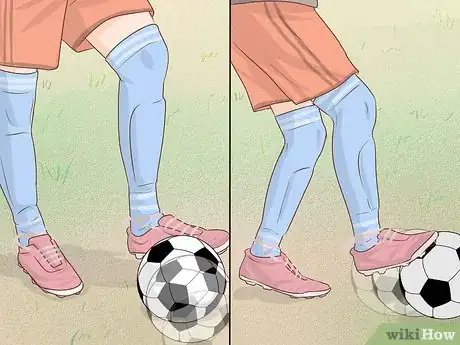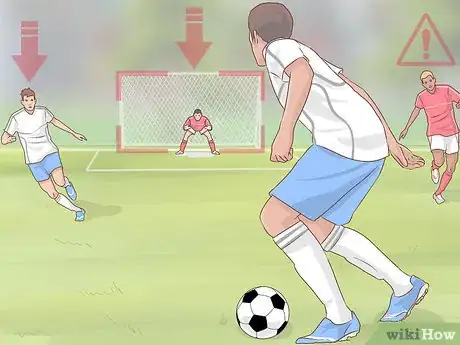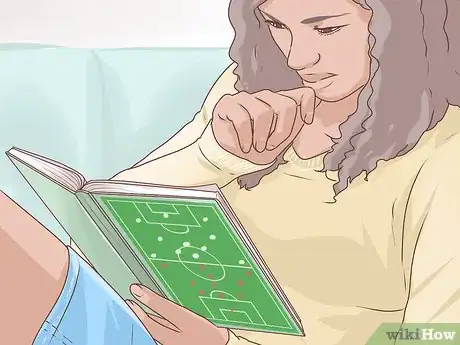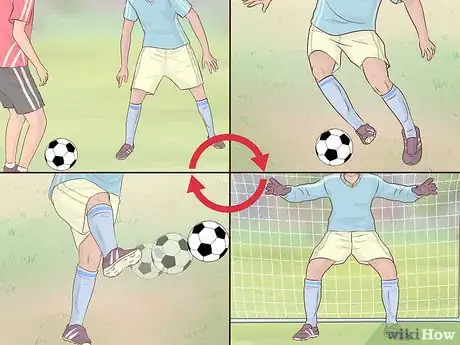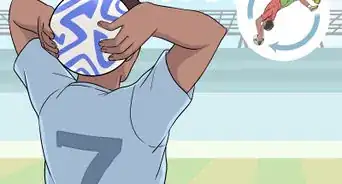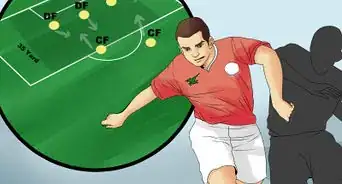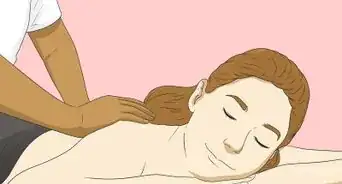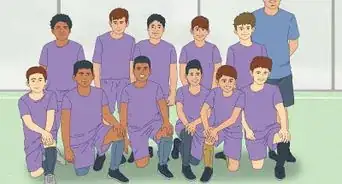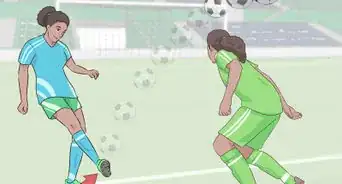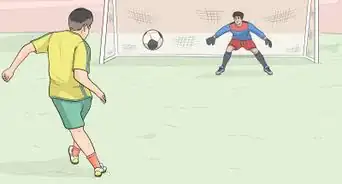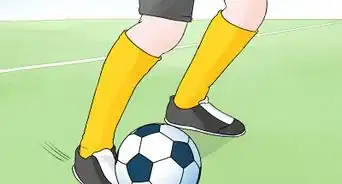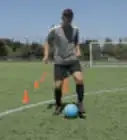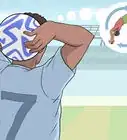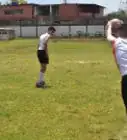This article was co-authored by Walter Merino. Walter Merino is a Youth Soccer Coach and Co-Founder of Ole Soccer Club based out of the Los Angeles, California area. He has coached youth from the age of four to the high school and college levels. Walter has played collegiate soccer for Cal Poly Pomona and Los Angeles Mission College. His accomplishments include coaching Olé Soccer Club to win the 2017 Cal South State Cup Governors Boys 2007 Division title.
There are 9 references cited in this article, which can be found at the bottom of the page.
wikiHow marks an article as reader-approved once it receives enough positive feedback. This article received 16 testimonials and 86% of readers who voted found it helpful, earning it our reader-approved status.
This article has been viewed 385,225 times.
Soccer is the world's game for a good reason -- it is both simple enough to learn in an afternoon and complex enough to spend your whole life learning. Being a better soccer player means different things to different people, but good ball control and on-field intelligence are essential for any player. Once you have felt the feeling of scoring, making that important assist pass, or being a wall at the defense, you will be hooked on the sport for life.
Steps
Improving Your Foot Skills
-
1Perfect your first touch, setting yourself up for your next pass, shot, or dribble without pausing. Your first touch is essential, and this skill is what separates the pros from the amateurs. You need to be able to stop a ball at your feet from the air or from the ground, laying it right in front of you so that your next touch can immediately start the attack. Make sure you learn to "trap" the ball with your whole body by:
- Close-range one-touch passing with a partner. If your very first touch is an accurate pass, defenders will have fits trying to steal the ball from you. You can also practice this by kicking against a wall.
- Having a teammate or friend throw or cross a ball in the air. You must take only 2 touches -- one to settle, the other to pass it back to them.
- Passing and shooting on the run. Have someone feed you a ball on the run, timing your first touch so that you can pass or shoot on the second touch without breaking stride.[1]
-
2Practice close-touch ball handling drills. Your goal with the following exercises isn't just to get faster, it is to get more precise, learning to control the ball with your entire foot to become a better dribbler and passer. Try out these drills, aiming for 100 touches on each foot with each drill:[2]
- Bounce the ball between your feet, using the insoles to keep the ball between your knees and "passing" back and forth as quickly as possible.
- Tap the ball rapidly on the top with your toes, working on getting as quick as possible. As you improve. Work on actually rolling the ball slightly with the sole of your toe, focusing on this small, precise touch.
- Try the "in-and-out." Use the sole of your right foot to roll the ball to the right. Roll your foot all the way over the ball to the right, then use your instep to pass the ball to the left foot. Control it with the sole of your left and roll it out, repeating the drill with both feet, back and forth.[3]
Advertisement -
3Practice pulling off shots and crosses on the run. If you've been playing for a while, you generally know how to shoot and cross effectively when the ball isn't moving. But this isn't especially "lifelike" in a real game, and you'll be leaps and bounds above the competition once you're accurate and powerful on the move. Luckily, this is an easy skill to practice both alone and with a partner. Simply take a touch, get up to roughly 75% full speed, and then take the shot.
- As you get better, pick up the speed. Once you can hit a dead sprint, take a touch, and fire off a shot or cross, you'll be a defender's worst nightmare.
- Approach from a variety of angles, from hitting shots while running up the center of the field to working on crosses across your body from the sidelines.
- Work on your position's skills. A defender, for example, needs to be able to turn the ball and hit up the field as fast as possible to release pressure from an attack.
-
4Pay attention to your "opposite" or non-dominant foot. It doesn't matter how good your right foot is when you're up against top defenders, who will learn to quickly force you to your left. Great players are dangerous with both feet, forcing defenders to cover all the options. Don't eliminate half of your body from your arsenal -- make sure you work both feet.
-
5Learn to dribble with precise, tight control. The ball should feel like an extension of your foot. Take it into a small area (like the penalty box) and just dribble between the lines, varying your speed with sharp sprints and quick stops. Try out a few moves and use both feet, working until you tire out. Your goal is to get the ball as tight to your feet, at any speed, as possible. You'll make defenders lives much harder, and you can continue training by:
- Setting up obstacle courses with flags, cones, or old T-shirts. Make yourself zig-zag, weave, and change directions as fast as you can without losing the ball.
- Juggling may seem "useless" in a real game, but it is the easiest way to improve your touch on the ball, keeping it close with your entire body. Work on both feet, as well as the length of your touch, alternating tight, small juggles and higher, harder to handle touches.
- Work on some advanced moves and tricks, as they require precise ball control and give you new offensive tools in games.
-
6Learn to hit the ball in different areas to get different spins and shots. Where and how you hit a ball will greatly change how it travels, and the best players have the best ball control. Whether on offense or defense, learning how to use the whole ball greatly increases your options anywhere on the field.
- Short and accurate passes usually occur with the inside of your foot. Even precise, mid-level crosses can be hit this way.
- Hitting the ball on the outside thirds will cause it to bend if you use your laces. Work on getting under the ball a bit, as if hitting it from a diagonal angle.
- You can knuckle the ball by cracking it with laces just below dead center and avoiding a follow-throw, taking away the spin and causing the ball to dip unpredictably.
- Get under the ball, using the edge between your laces and instep, for a backspin chip, which is good for precise crosses that can't bounce or skip away.[4]
- Always follow through with your foot when you hit the ball, whether it's a shot, a pass, or a cross. This will give you more control over where the ball goes.[5]
Improving Your Soccer IQ
-
1Learn one-on-one defending to be useful anywhere on the field. From strikers to center-backs, everyone needs to know individual defending. So get a partner and start playing 1v1, working on handling your man and pressuring him effectively. When defending one on one, remember to:
- Stay slightly crouched and on the balls of your feet. Your knees should be bent in an athletic position, allowing you to react quickly.
- Angle your body, with one foot ahead of the other, so that you invite the attacker to go to one side. Force them to the sideline, or to your other defenders, instead of standing straight up and letting them choose your direction.
- Watch a player's hips to avoid getting tricked. Your hips are your center of gravity, and they generally telegraph where a player is going unless they're Lionel Messi. It is almost impossible to quickly change your hips direction, and you can use this to your advantage as a defender.
-
2Keep your eyes up throughout the game, especially when you have the ball. Great players are always scanning the field, especially when they have the ball. This takes practice, as it's harder to control a ball you can't see. But learning to use the bottom of your eyesight while scanning the field is an essential skill to become a smarter, and thus better, player.
- Use practices to work on keeping your head up. Turn the ball over now, not in games, and you'll quickly see improvement.[6]
-
3Communicate on the field, talking constantly to aid your team. Great players are always talking: "Open man," "I've got the ball," "I need some help," and much, much more is constantly being shouted on the field, and there is a good reason. Soccer is a team game, and intelligent players know the team must be on the same page for all 90 minutes to get the most out of the game. Be a team leader and start chattering every game and practice. Essential things to talk about throughout the game include:
- Defensive Marks: let your team know who you're covering if you want to challenge the ball, and if there are any unmarked defenders who need to be covered.
- Advice to the player dribbling: don't shout tons of info at them, but don't leave them in the dark. Tell them when they have time and when there is a "man on."
- Making Runs: Tell your teammate you're "overlapping!" or that "you can play it back" if they need. When you make a big run, don't assume they will always see you, especially if their head is down.[7]
-
4Watch professional games at least once a week, learning from the best. Note where the players are not just when they have the ball, but off of it. What runs are people in your position making? When do they move up to attack and when do they peel back. Don't be afraid to be a bit of a critic -- use these games to learn new ideas and break down why certain things didn't work. How would you play differently, and how would you like to emulate your favorite players?
- Burgeoning players can also check out tutorials, clips, and highlights on YouTube, which can help fill in gaps if you're unsure what techniques the pros are using on shots or passes.
- Find a team or league you love and become a fan -- the more you watch the better your play will be.
-
5Learn the basics of team tactics, becoming a team leader on offense and defense. A big part of soccer intelligence is learning how to work as a team. While each team has specific strategies that they must develop together, there are some tactics that hold true no matter what team you're on:
- Contract on defense, expand on offense. This is the basis of all strategies -- you want to take away space on defense and create space when attacking. So, on defense, you come together near the center of the field, forming a unified base and moving together to prevent offensive threats. On offense, you try to make them break this base by stretching out to defend you and your team.
- Follow up all shots, forcing the defense to react. Even decent shots can turn into goals if your team is crashing the goal on shots and crosses. This sort of pressure can upend defenses, as defenders will face their own goal on a rebound and have a very hard time clearing it safely.
- Keep your shape defensively. Even if you're not playing an offside trap, the defense should be on a horizontal line, holding shape. When defenses lose this shape, they create gaps and holes between themselves. If you play in the back, always look left and right and keep everyone in a mostly even line.
Developing Your Talent to the Fullest
-
1Try out and play for the best teams you can find. There are no shortcuts to being a better soccer player other than playing as much as you can. That said, you'll get much better much faster if you're up against the toughest competition you can handle. Try out for a team that pushes you, or, if that's not possible, make challenges for yourself. Go join the local adult pick-up game (just bring cleats and jump on the field,) get your teammates to play with you in the offseason, and keep practicing alone when there is no one to join you.[8]
-
2Get fit for your position to get the most out of training. While all soccer players need to train to get the most out of their play, all players need to train differently. By thinking about your position's specific needs you can get the most out of your body and be the biggest asset to your team.
- Goalies: Focus on your strength, reaction time, and a slim, quick figure that can move in an instant.
- Defenders: Must be physically strong, both upper body and lower, to win any tackle or challenge. Need great sprinting speed as well, and should be fit.
- Midfielders: Must be able to run and run and run. Quick decision making, and the touch and passing ability to back it up, are essential.
- Forwards: Should be fast and able to jostle with strong defenders. They also tend to be endurance runners, able to jog around all game to make space and still win a sprint to the end line.
-
3Keep moving off the ball, not just when you may receive it. Great soccer players rarely stand still. As defenders, you are constantly shutting down space and reacting to the offense. As a midfielder, you're constantly scanning the field and moving to the ball, opening up space in the middle. As a striker, you're constantly trying to outfox a defender, slipping by them or disappearing when they are ball watching. You must always be moving, keeping the field open and dynamic and the other team guessing -- standing still makes you almost useless to your team.
- Check to the ball, even if you don't get it. As soon as you appear, demand the ball, but leave immediately if you don't get it. You'll have a defender following you, which opens up the space you were just in for your team.
- Spread wide when your team gets the ball if you play near a wing -- a quick counterattack to the sidelines often has the most space to push forward.
- If you don't have a man to mark, fill in the space an attacker might want. Try to figure out the most dangerous passing lanes to goal and sit in them, clogging them for the other team.[11]
-
4Take every practice seriously, working on your weak spots. Practice is the time to get over your weaknesses, not impress your teammates. Treat each practice like a warm-up for a huge game, working yourself hard in every drill and testing out new moves now so that they become second-nature in a game.
- Play multiple positions -- improve as both a shooter and a defender
- Focus on both feet -- no one cares if you turn it over now, but they do care in games.
- Play quickly in practice especially. Don't slow down or take it lightly, even if your defenders are putting less than game pressure on you.
-
5Play and make decisions as quickly as possible. Scouts and coaches look a lot at your pace of play -- how fast you receive the ball, look up, and pass/shoot/dribble. Don't hold onto the ball too long, and practice making quick, decisive decisions on the ball, pushing yourself to play with urgency. Good ways to do so include:
- Pass the ball and keep moving. A few quick touches are usually enough, as the ball moves much faster than you can run. The longer you're in the same area, the longer the defense has to shut down holes and get set.
- If you plan to dribble, do so at a good quick pace instead of slowly. Put the defenders on the back foot.
- Look for crosses, especially ones that force the defenders to face their own goal. Big passes force a defense to scramble into new positions quickly, which often opens up holes.[12]
-
6Search out advice, guidance, and coaching in your weak areas. No matter how much better at soccer you get, you'll never be a perfect player. Soccer requires 11 players in complete unison to succeed, so keep your ears open to your coaches and mentors. Each player has specific weaknesses they can work on -- don't close your ears to your own.[13]
- Ask your coach what you can do to get better a few times a season. How can you work on your own skills outside of practice?
- Consider calling in a personal coach or trainer to work on the skills you don't have time for in practice. If you really want to excel, especially in an area without high-level teams, you'll need the individual attention.
How Can I Be A Great Soccer Defender?
Expert Q&A
Did you know you can get expert answers for this article?
Unlock expert answers by supporting wikiHow
-
QuestionHow can I improve my soccer skills?
 Walter MerinoWalter Merino is a Youth Soccer Coach and Co-Founder of Ole Soccer Club based out of the Los Angeles, California area. He has coached youth from the age of four to the high school and college levels. Walter has played collegiate soccer for Cal Poly Pomona and Los Angeles Mission College. His accomplishments include coaching Olé Soccer Club to win the 2017 Cal South State Cup Governors Boys 2007 Division title.
Walter MerinoWalter Merino is a Youth Soccer Coach and Co-Founder of Ole Soccer Club based out of the Los Angeles, California area. He has coached youth from the age of four to the high school and college levels. Walter has played collegiate soccer for Cal Poly Pomona and Los Angeles Mission College. His accomplishments include coaching Olé Soccer Club to win the 2017 Cal South State Cup Governors Boys 2007 Division title.
Soccer Coach
-
QuestionWhat kinds of food make your body strong?
 Community AnswerFoods high in fiber and lean proteins make for a strong body. Also be sure to stay hydrated with water consume plenty of fresh fruits and vegetables each day.
Community AnswerFoods high in fiber and lean proteins make for a strong body. Also be sure to stay hydrated with water consume plenty of fresh fruits and vegetables each day. -
QuestionDo I need to train to be better?
 Community AnswerOf course. You have to practice anything you want to get better at.
Community AnswerOf course. You have to practice anything you want to get better at.
Warnings
- If you are coming from an inactive lifestyle, try to ramp up the training load slowly. If you feel your muscles hurt the day after training, wait until it is gone.⧼thumbs_response⧽
- If you don't stretch, you may pull a muscle.⧼thumbs_response⧽
- Wait until your body has fully recovered from an injury before playing a game or practicing. Continuing to engage in physical activity while you're still recovering could worsen the injury in the long run or delay healing.⧼thumbs_response⧽
References
- ↑ http://www.soccer-training-info.com/ignite_your_first_touch.asp
- ↑ http://healthyliving.azcentral.com/really-good-foot-skills-soccer-less-two-weeks-9885.html
- ↑ http://www.active.com/soccer/articles/soccer-tips-for-playing-better-defense
- ↑ http://www.soccer-training-info.com/strike_the_soccer_ball.asp
- ↑ Walter Merino. Soccer Coach. Expert Interview. 29 January 2020.
- ↑ http://healthyliving.azcentral.com/really-good-foot-skills-soccer-less-two-weeks-9885.html
- ↑ http://coachingamericansoccer.com/tactics-and-teamwork/on-field-oral-communications/
- ↑ http://www.soccer-training-info.com/soccer_tips.asp
- ↑ http://www.soccer-training-info.com/ways_to_become_professional_player.asp
- ↑ Walter Merino. Soccer Coach. Expert Interview. 29 January 2020.
- ↑ http://www.coachingsoccerweekly.com/014-do-your-players-move-without-the-ball/
- ↑ http://www.soccer-training-info.com/soccer_tips.asp
- ↑ http://www.soccer-training-info.com/ways_to_become_professional_player.asp
About This Article
If you want to get better at soccer dribbling by yourself, start practicing ball handling drills to improve your dexterity and speed. While you're at it, make sure you train your non-dominant leg so you'll be less predictable in-game. You should also train one-on-one defense with a partner by angling your body to guide your opponent and by watching their hips to predict where they'll go next. Finally, communicate with your team during games so you know who's open or who has the ball. Scroll down to learn how to get better at kicking and strategy!
